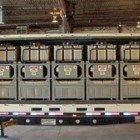One of the biggest topics for the 20,000 people gathered in San Francisco for the Intersolar conference this week is that of energy storage.
Solar, and solar PV in particular, is being expanded at breathtaking speed, but the long term value of those installations, both to the consumer and the grid operator, seems to be intertwined with the ability to store that electricity. Storage, it seems clear, is the deal-breaker, or the deal-maker, for both new generation technologies, and the incumbents who operate the grid.
Which means there are two key questions about storage that everyone wants to know the answer to: those of costs and of value – which technology will deliver the cheapest option, and what the value of those technologies are for the owners and the operators.
There were a whole series of interesting speakers on the first day of the conference that we will try and get to in the next few days. But to start off, it’s probably worthwhile giving a quick overview of why it is that energy storage is needed, particularly as the global solar PV market surges inevitably to the 100GW annual market by the turn of the decade; and how some of the cost and value challenges are being viewed.
Ash Sharma, senior research director with research group HIS, said there were four key drivers for energy storage.
Self consumption: PV generation does not always align with residential demand, and in some cases the feed-in tariffs have fallen below the retail price. That makes it attractive for home-owners to use as much of the electricity they produce from rooftop solar as they can. Storage helps that self-consumption.
The second reason is in the commercial sector, where load profiles actually align with the solar PV generation profile quite nicely. But storage can be used to shift consumption around to avoid peak demand charges, which are common in commercial energy rates. And it can be used as back-up power.
At the utility scale, storage is invaluable to help control voltage and ramping issues, and in many cases it is a regulatory requirement. In Puerto Rico, for instance, a 2MW installation had to be accompanied by storage for that reason. It can also help balance and strengthen the grid in many instances, particularly in those areas – such as in Australia, Germany and in some suburbs in Los Angeles – where the penetration levels are getting to the point that the grid can’t, or won’t, take more.
And, of course, there is the off-grid opportunity. Renewables without storage are extremely variable and any off-grid application that seeks steady source of electricity has to have storage. Because of the costs, this is also the biggest commercial opportunity at the moment.
Right now, however, the problem is with cost. Sharma said adding storage to PV installations right now actually diminishes the return on investment – even if it does represent an IRR of around 7 per cent in Germany. But this is expected to change rapidly as the costs of storage come down, and as new incentives are provided that reflect the value of that investment. Some suggest that even now the IRRs can double with those incentives.
Sharma says one of the problems is that energy storage is an immature market with no mass production. What it needs is scale. Once it gets that, IHS predicts a fall of at least 40 per cent in coming years, as battery technologies are rolled out, and with the growing use of electric vehicles.
Mark Johnson, the program director for ARPA-E, the Department of Energy program that focuses on new technologies, says that storage needs to come down to the point where it is adding only around 2.5c/kWh to the cost of electricity to make the technology effectively “invisible” to the consumer.
To do that however, the cost of storage must come down to around 100/kWh – which he said was less than one-quarter of the best estimates to date. ARPA-e is focused on finding a technology that can deliver a “10 times” step change in costs.
Janice Li, a consultant with Strategem, and a member of the California Energy Storage Alliance (CESA), says energy storage will be a system-wide game changer, but the key lies not in the cost, but in the value to the grid, and the high renewable scenarios are the ones that create the most value.
“Storage is much more cost-effective than the way we do things today,” she said. “It’s not just about cost, it’s about value, value, value.”
The key, she said, was to reframe the markets that were not geared around the assumption that only fossil fuels could provide a response to demand changes.
Energy storage was in fact faster and accurate in its response time, and in the US, market rules and tariffs are being drawn up to recognise and value that. “If you are fast, you get paid more. That is the value proposition for energy storage.”
Lin argued that in some areas, storage is commercially viable and funded on a merchant basis already. What is needed is long-term contracts to support the up-front cost of financing equipment.
“It is clear that with the transformation of the global energy systems, wind and solar will be the two main pillars of these new systems,” said Professor Eicke Weber, the head of Germany’s Fraunhofer Solar Institute. “And to address that, we need to do something about storage. But it is the fastest growing sector and we will see big falls in costs.”








